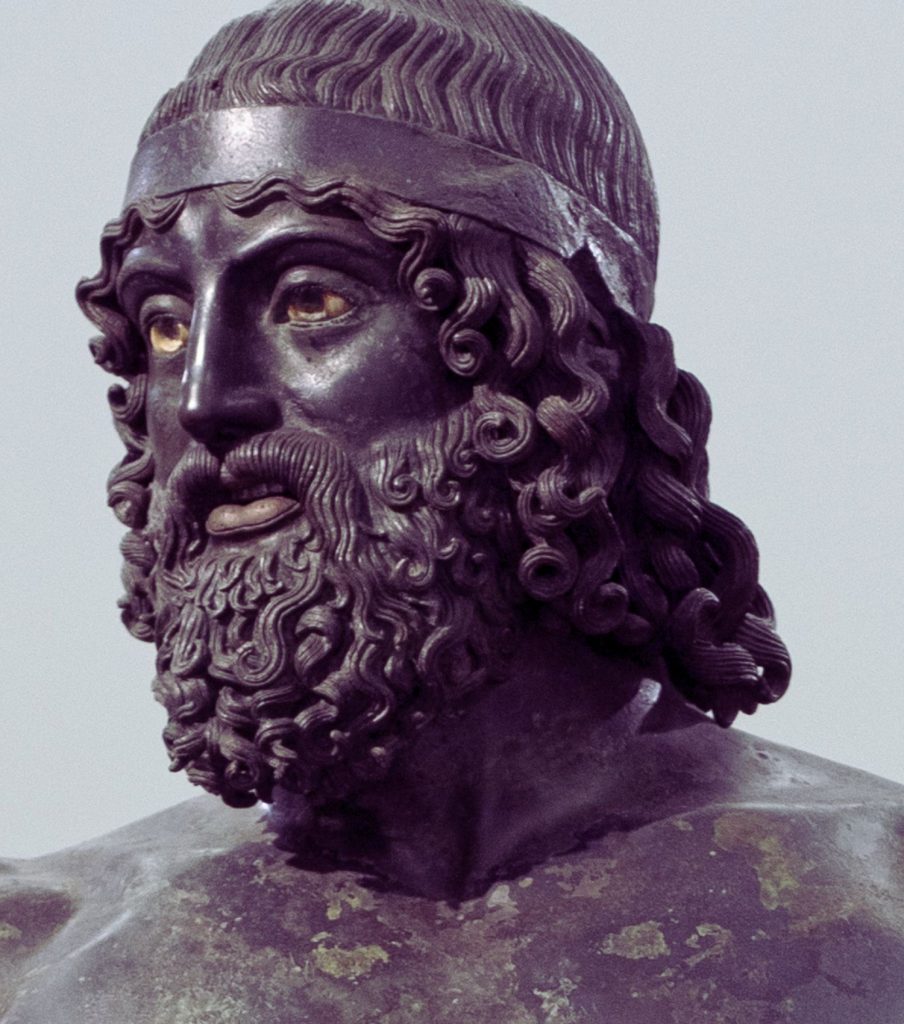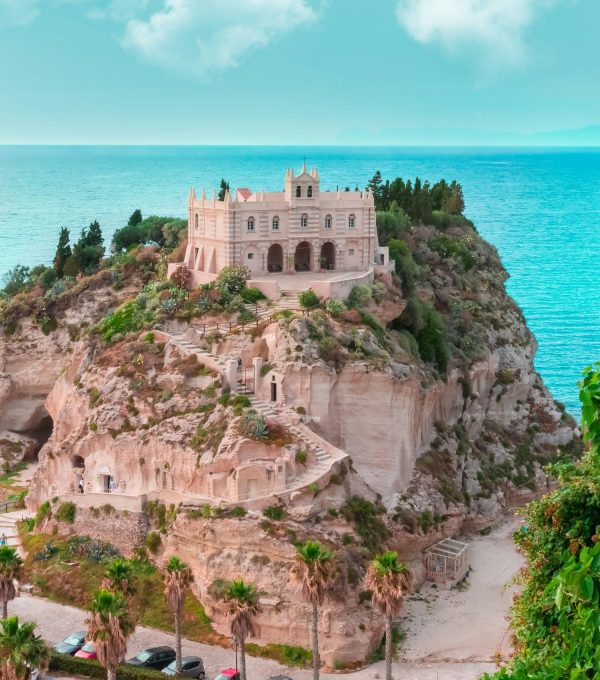The Riace Bronzes are two famous bronze statues dating back to the Classical Greek period V century BC, discovered in 1972 by a diver off the coast of Riace, Calabria. They are exhibited at the National Archaeological Museum of Reggio Calabria, where they have become one of the main tourist attractions of the city and the region.
Description of the two statues
After recovery, the statues of the Riace Bronzes underwent a major restoration between 1975 and 1980 in Florence. The intervention focused on cleaning and preserving the external surfaces. Later, the removal of the fusion earth continued in the restoration laboratory of the Museum of Reggio Calabria between 1992 and 1995.
The melting earth of ancient Greek statues is the material used to create the moulds necessary for the casting of bronze statues. This material, composed mainly of clay, was modelled around the original model of the statue, allowing sculptors to create a mold perfectly suited to the casting of bronze. Once the mold was completed, the pattern was removed and the bronze was poured into it to create the replica of the statue. The fusion earth was fundamental in the process of production of bronze statues in ancient Greece.
Finally, the last phase of the restoration took place between 2010 and 2013 in the rooms created specifically for restoration at the Regional Council of Calabria, since the Museum was closed for modernization works. The two statues, known as “the young” and “the old”, now have a height of about 1.98 and 1.97 meters respectively, with a weight reduced from 400 to about 160 kg after the removal of the casting earth.
The statues, both slightly larger than natural, depict two Greek warriors completely naked and standing, with dynamic and expressive poses.
They are remarkable for their extraordinary artistic mastery and for their surprisingly good state of conservation, considering the age and the fact that they were recovered from the sea floor.
It is unclear whether they were originally a single work or whether they were only pulled together during transport. The role of the statues has also been the subject of debate, with hypotheses that identify them as athletes, heroes or gods.
Analysis of fusion lands revealed that both statues have Greek origins, from Attica and Argolis respectively. The two Bronzes show heroic nudity and a similar posture, with the right leg bearing and the left bent. Originally the two statues were accompanied by weapons, now disappeared, most likely by Corinthian helmets, a hoplite spear and a shield.
The anatomical details are rendered with extreme precision, with veins and muscles visibly highlighted, so much so that experts have thought of the names of the most important artists of Greek sculpture such as Phidias, Polycletus and Pythagoras of Reggio.
Their body pose is called chiasma, and is an anatomical arrangement in which the body parts are arranged in a cross or “X” shape. In this position, if you draw an imaginary line from top to bottom and from inside to outside the body, you will notice that the body segments cross along this line. For example, the arms and legs are placed so that the right arm crosses with the left leg and vice versa.
The eyes of the two statues are made of white calcite, with irises in glass paste and fleshy tear in pink stone. Lips, eyelashes and nipples are made of copper, while the teeth are in silver foil. Both statues are produced with the lost wax casting technique, a very common technique in ancient Greece.
Bronze A (young warrior) has a worked hair and a thick beard, with strands shaped individually; on the front is applied the Kyne, band that frames the curls and gives royalty to the hairstyle.
Bronze B (old warrior) has a smooth head, deformed upwards to better accommodate the Corinthian helmet raised on the head in order to leave the face uncovered. The precise dating of the Riace Bronzes is still the subject of debate, but they are considered two masterpieces of Greek bronze from the 5th century BC.
The two warriors are displayed in rooms created for this purpose in the National Archaeological Museum of Reggio Calabria, with constant humidity and where few people enter at a time.
The anti-seismic base of the Riace Bronzes in the Archaeological Museum has been realized with cutting-edge technologies, of fundamental importance for the conservation and safety of these precious works of art. The base was designed and built with the aim of protecting the statues from damage caused by earthquakes or other natural disasters, taking into account the high seismicity of the Calabria region.

Foto : RaiCultura
The National Archaeological Museum of Reggio Calabria
The National Archaeological Museum of Reggio Calabria (MArRC) is an important avant-garde museum located in the city of Reggio Calabria.
It was designed by the famous architect Marcello Piacentini in the thirties of the last century. Located in the heart of the city, the Museum is an important element of the urban landscape and the life of the Reggini. It overlooks, on one side, the central Piazza De Nava, on the other, the waterfront Italo Falcomatà, with the beautiful view of the Strait of Messina. It was born from the fusion of the State Museum and the Civic Museum, inaugurated in 1882 to preserve local archaeological finds.
After the damage caused by the earthquake of 1908, the creation of a National Archaeological Museum was promoted. The palace was ceded to the Ministry of Education in 1948, and the Civic Museum was suppressed. In November 2009, the Museum was closed for restoration and finally reopened to the public on 30 April 2016. The main architectural element of the current layout is the new inner courtyard, covered by a transparent glass ceiling, supported by a technologically advanced structure, and thanks to this technique, the atrium is flooded with light.
The Museum is famous above all for the famous Riace Bronzes and for the two beautiful Philosopher’s Head and Head of Basel, but also boasts a vast collection of archaeological finds from Calabria and other surrounding regions.
With 220 shop windows and four exhibition floors, the museum itinerary tells the history of Calabria from prehistory to the Roman age.
The tour of the Museum is divided into levels, each corresponding to a floor of the building, the visit begins chronologically from the second floor.
Here is a short list of the museum routes:
Second floor: Level A – Prehistory and Protohistory – before Magna Graecia and age of metals (from 120,000 to 12,000 years ago);
First floor: Level B – Cities and sanctuaries of Magna Grecia (Crotone, Medma, Hipponion, Sibari, Caulonia and Locri);
Mezzanine: Level C – Necropolis and daily life of Magna Grecia – Lucani and Brettii;
Ground floor: Level D – History of Reggio Calabria until Roman times – The bronzes of Riace and Porticello;
Basement: Level E – Temporary exhibitions of Marc and access to the Hellenistic necropolis.
The Hellenistic necropolis located in the basement of the Museum, was discovered during the construction of the Museum itself and refers to the ancient Greek Rhegion. The necropolis includes about 100 tombs of various types, from simple ustrina to brick rooms with barrel vaults or book cover. It dates back to the IV-II century B.C. but more ancient finds suggest a use already from the classical age.
Noteworthy is that the Marc houses the richest and most complete collection of Greek bronzes of the 5th century B.C. called the classical period.
Useful information to visit the Marc
Opening days and hours: from Tuesday Sunday, from 9.00 to 20.00
Last entry at 19.30
Free entry on the first Sunday of the month
Guided tours available in Italian and English
How to reach the Archaeological Museum of Reggio Calabria.
By car: reach the museum following the directions to Reggio Calabria and then to the city center. The museum is located in the heart of Reggio Calabria, then follow the signs to the historic center or the area of the promenade “I. Falcomatà”.
Public transport: Reggio Calabria is well served by buses and trains. Tourists can take a local bus or train to Reggio Calabria and then use local public transport or walk to reach the Museum, which is located in a central location easily accessible.
On foot: you can easily reach the Museum on foot. It is located near the central Piazza De Nava and the promenade Italo Falcomatà.
Regardless of the means of transport chosen, once you arrive in Reggio Calabria, you can ask for local information at the Tourist Offices, one is located in Via Marina 2, the other near the Railway Station in Piazza Garibaldi. Just ask for a map of the city to find the best way to reach the Archaeological Museum.



